Case Management Evolution and Analysis: WEL418, CSU, Semester 2
VerifiedAdded on 2022/08/28
|12
|3470
|14
Report
AI Summary
This report provides a detailed analysis of case management, starting with a personal reflection on experiences with a human service organization, specifically Centrelink. It then delves into the definition and evolution of case management, exploring different models such as Clinical Case Management and Brokerage Models, and the theories underpinning them. The report also contrasts person-centered and service-provider driven models, discussing potential tensions and conflicts that can arise in practice. The author also discusses the differences between person-centered and service-provider driven models and the tensions and conflicts that can arise between them in the real world. The assignment is a critical examination of case management principles and their application within the healthcare field.
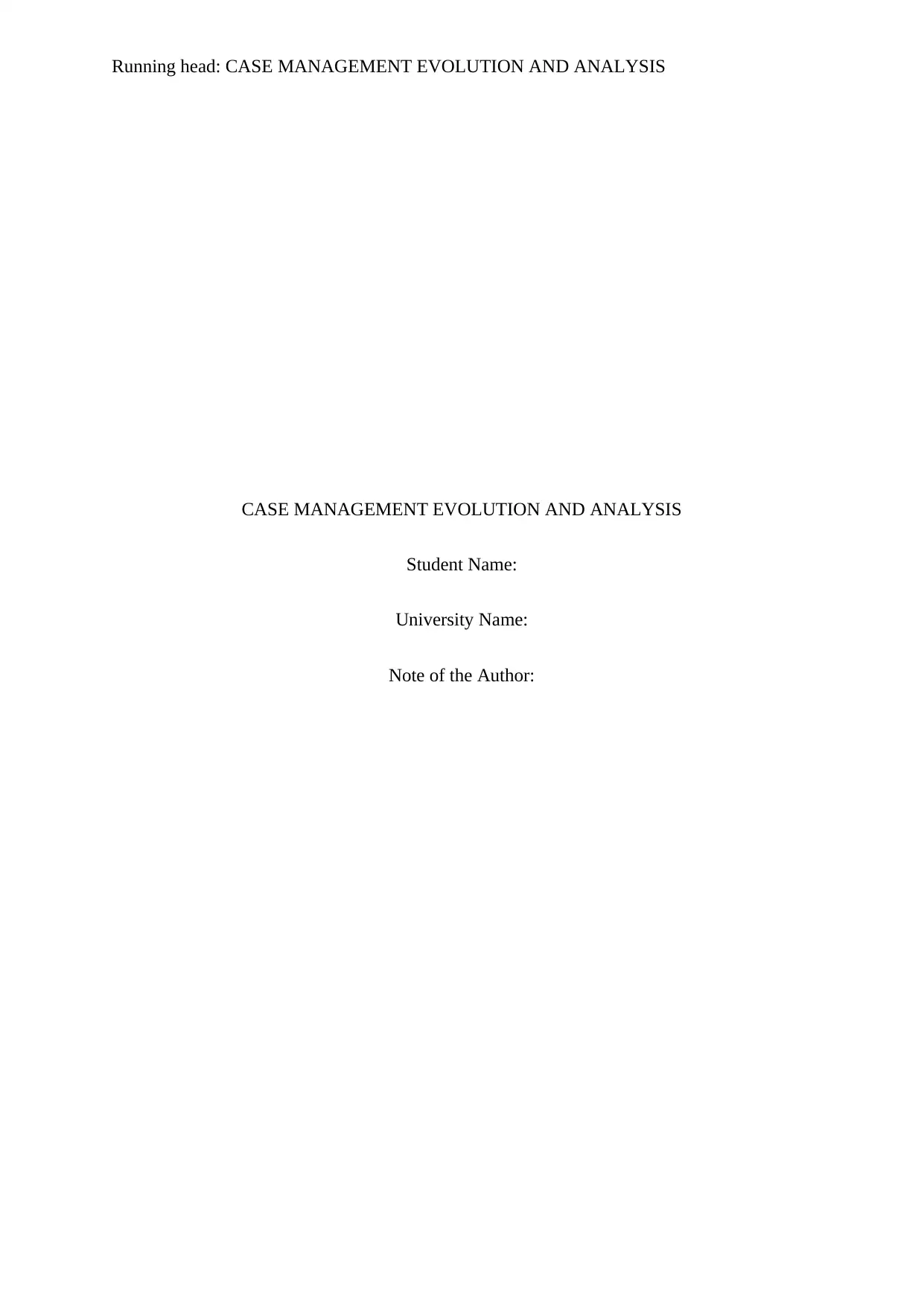
Running head: CASE MANAGEMENT EVOLUTION AND ANALYSIS
CASE MANAGEMENT EVOLUTION AND ANALYSIS
Student Name:
University Name:
Note of the Author:
CASE MANAGEMENT EVOLUTION AND ANALYSIS
Student Name:
University Name:
Note of the Author:
Paraphrase This Document
Need a fresh take? Get an instant paraphrase of this document with our AI Paraphraser

1CASE MANAGEMENT EVOLUTION AND ANALYSIS
Reflection Summary of using a Human Service Organization:
Centrelink Master Programme is a service that is arranged by the Government of
Australia to provide services to the familiar people of the nation. The basic service offered by
them is financial help to the people in their emergencies such that they can deal with their
crisis in a secure manner. They provide these services to any kind of people like retired
people, the unemployed ones, the needy families, the patients, disabled people, the students,
and many more. I being a citizen of Australia, also deserve to get facilities from the services
of Centrelink. Thus I applied for some monetary help from the organization during my
accident and severe health condition due to it. However, I had the most dreadful experience
of my life while acquiring services from this organization that is associated with humanity
services. They harassed me at large when I applied for a sickness allowance, and I will never
return here for any kind of help.
The worst part of the Centrelink Programme is the behavior of the staff that I had to
deal with during the crisis of mine. When I asked them for monetary help, they asked me for
my birth certificate and other formal documents that they would require for granting me the
allowance. When I had sent them everything by my family members, they were not
convinced enough to believe me. They were bent on forcing me to get out of the hospital bed
and submit the documents on my own and stated to me that this is their procedure of work.
When I tried to talk to the managers of the organization, they behaved extremely rudely with
me, saying that I am claiming support for wrong reasons, and it is not justified by them to
help me.
In spite of me calling them the innumerable number of times, they did not bother to attend
my phone calls, and at last, I was forced to visit their organization for the sake of my own
betterment. Although they got assured that I do need some financial help for medical
Reflection Summary of using a Human Service Organization:
Centrelink Master Programme is a service that is arranged by the Government of
Australia to provide services to the familiar people of the nation. The basic service offered by
them is financial help to the people in their emergencies such that they can deal with their
crisis in a secure manner. They provide these services to any kind of people like retired
people, the unemployed ones, the needy families, the patients, disabled people, the students,
and many more. I being a citizen of Australia, also deserve to get facilities from the services
of Centrelink. Thus I applied for some monetary help from the organization during my
accident and severe health condition due to it. However, I had the most dreadful experience
of my life while acquiring services from this organization that is associated with humanity
services. They harassed me at large when I applied for a sickness allowance, and I will never
return here for any kind of help.
The worst part of the Centrelink Programme is the behavior of the staff that I had to
deal with during the crisis of mine. When I asked them for monetary help, they asked me for
my birth certificate and other formal documents that they would require for granting me the
allowance. When I had sent them everything by my family members, they were not
convinced enough to believe me. They were bent on forcing me to get out of the hospital bed
and submit the documents on my own and stated to me that this is their procedure of work.
When I tried to talk to the managers of the organization, they behaved extremely rudely with
me, saying that I am claiming support for wrong reasons, and it is not justified by them to
help me.
In spite of me calling them the innumerable number of times, they did not bother to attend
my phone calls, and at last, I was forced to visit their organization for the sake of my own
betterment. Although they got assured that I do need some financial help for medical
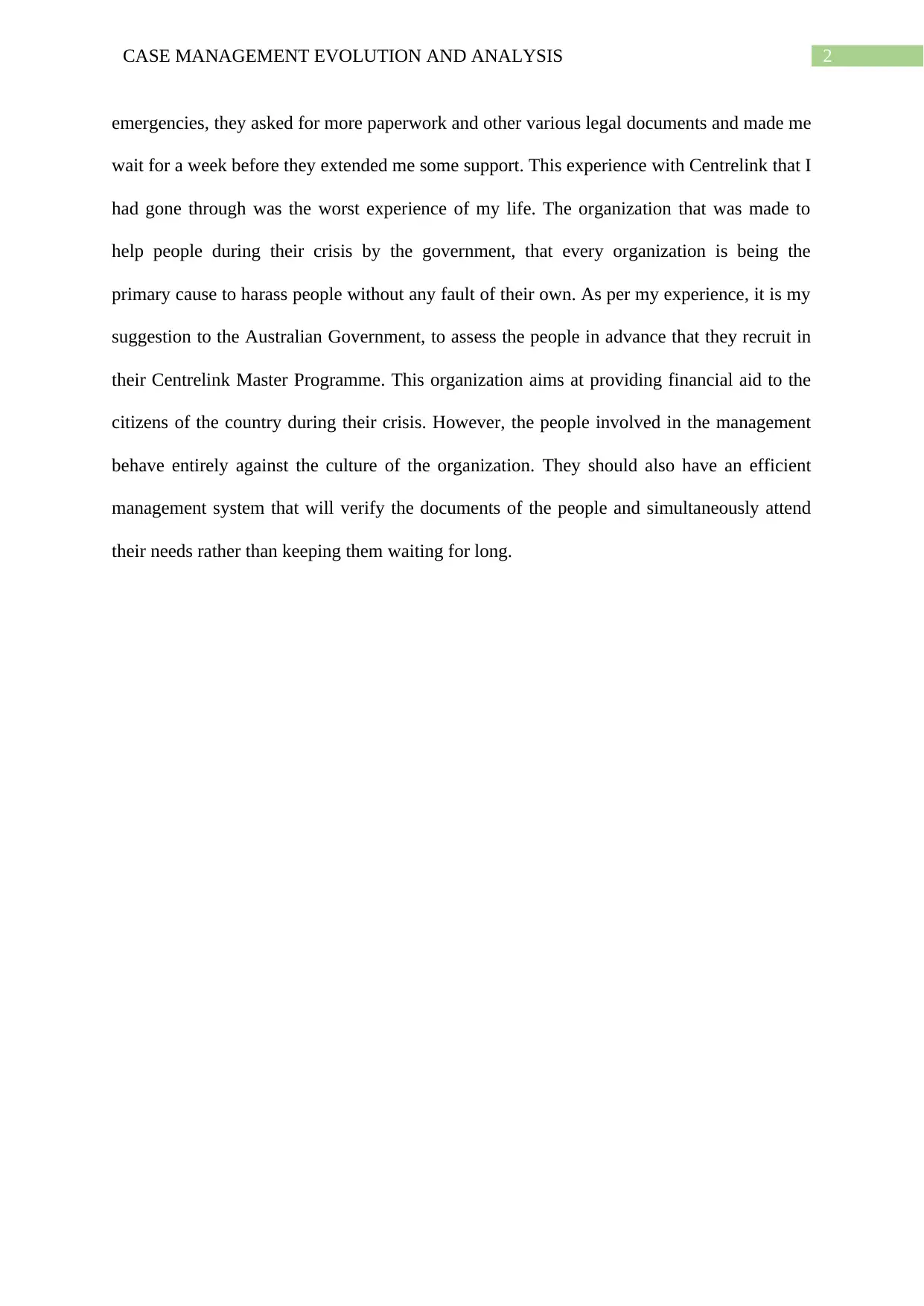
2CASE MANAGEMENT EVOLUTION AND ANALYSIS
emergencies, they asked for more paperwork and other various legal documents and made me
wait for a week before they extended me some support. This experience with Centrelink that I
had gone through was the worst experience of my life. The organization that was made to
help people during their crisis by the government, that every organization is being the
primary cause to harass people without any fault of their own. As per my experience, it is my
suggestion to the Australian Government, to assess the people in advance that they recruit in
their Centrelink Master Programme. This organization aims at providing financial aid to the
citizens of the country during their crisis. However, the people involved in the management
behave entirely against the culture of the organization. They should also have an efficient
management system that will verify the documents of the people and simultaneously attend
their needs rather than keeping them waiting for long.
emergencies, they asked for more paperwork and other various legal documents and made me
wait for a week before they extended me some support. This experience with Centrelink that I
had gone through was the worst experience of my life. The organization that was made to
help people during their crisis by the government, that every organization is being the
primary cause to harass people without any fault of their own. As per my experience, it is my
suggestion to the Australian Government, to assess the people in advance that they recruit in
their Centrelink Master Programme. This organization aims at providing financial aid to the
citizens of the country during their crisis. However, the people involved in the management
behave entirely against the culture of the organization. They should also have an efficient
management system that will verify the documents of the people and simultaneously attend
their needs rather than keeping them waiting for long.
⊘ This is a preview!⊘
Do you want full access?
Subscribe today to unlock all pages.

Trusted by 1+ million students worldwide
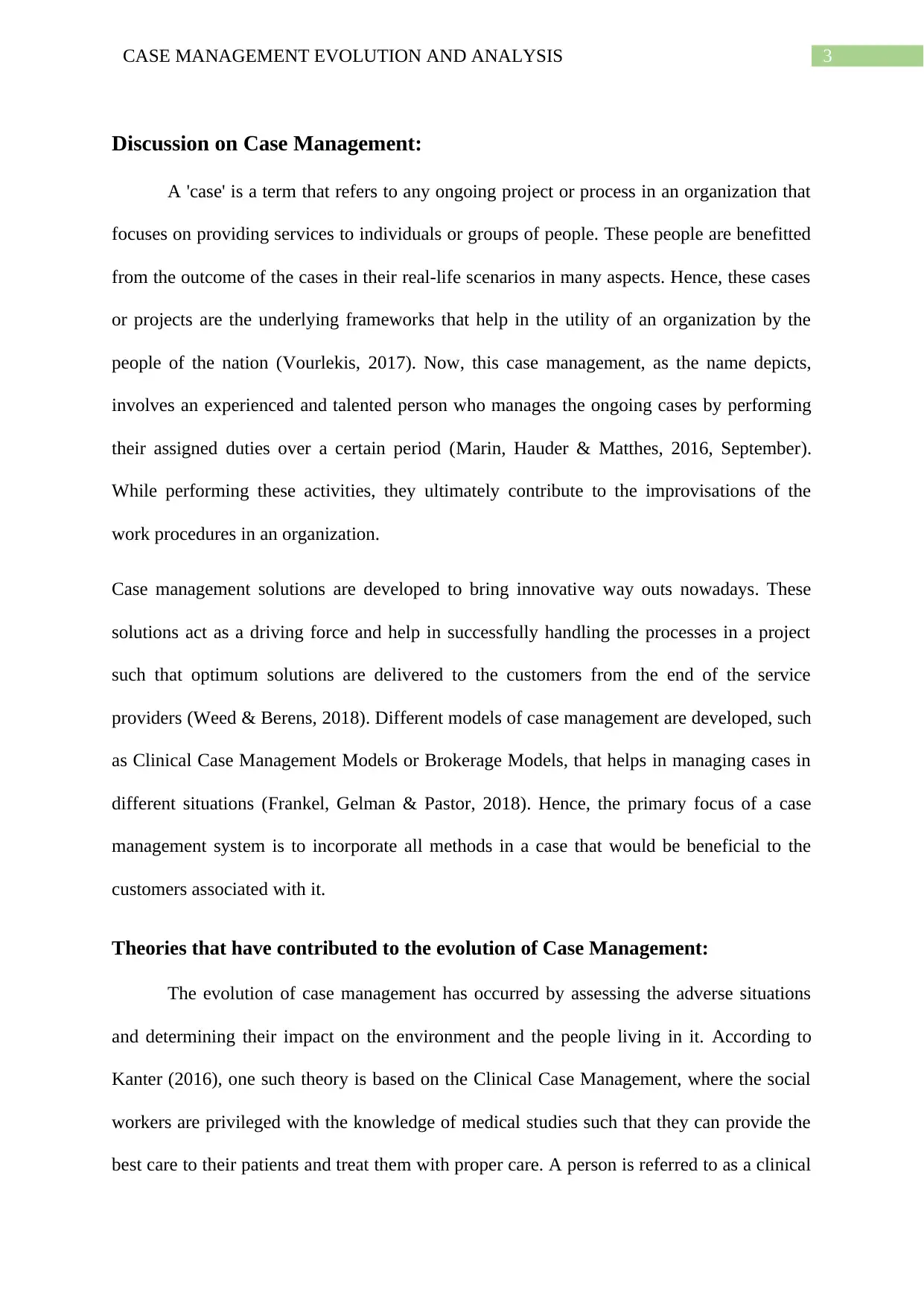
3CASE MANAGEMENT EVOLUTION AND ANALYSIS
Discussion on Case Management:
A 'case' is a term that refers to any ongoing project or process in an organization that
focuses on providing services to individuals or groups of people. These people are benefitted
from the outcome of the cases in their real-life scenarios in many aspects. Hence, these cases
or projects are the underlying frameworks that help in the utility of an organization by the
people of the nation (Vourlekis, 2017). Now, this case management, as the name depicts,
involves an experienced and talented person who manages the ongoing cases by performing
their assigned duties over a certain period (Marin, Hauder & Matthes, 2016, September).
While performing these activities, they ultimately contribute to the improvisations of the
work procedures in an organization.
Case management solutions are developed to bring innovative way outs nowadays. These
solutions act as a driving force and help in successfully handling the processes in a project
such that optimum solutions are delivered to the customers from the end of the service
providers (Weed & Berens, 2018). Different models of case management are developed, such
as Clinical Case Management Models or Brokerage Models, that helps in managing cases in
different situations (Frankel, Gelman & Pastor, 2018). Hence, the primary focus of a case
management system is to incorporate all methods in a case that would be beneficial to the
customers associated with it.
Theories that have contributed to the evolution of Case Management:
The evolution of case management has occurred by assessing the adverse situations
and determining their impact on the environment and the people living in it. According to
Kanter (2016), one such theory is based on the Clinical Case Management, where the social
workers are privileged with the knowledge of medical studies such that they can provide the
best care to their patients and treat them with proper care. A person is referred to as a clinical
Discussion on Case Management:
A 'case' is a term that refers to any ongoing project or process in an organization that
focuses on providing services to individuals or groups of people. These people are benefitted
from the outcome of the cases in their real-life scenarios in many aspects. Hence, these cases
or projects are the underlying frameworks that help in the utility of an organization by the
people of the nation (Vourlekis, 2017). Now, this case management, as the name depicts,
involves an experienced and talented person who manages the ongoing cases by performing
their assigned duties over a certain period (Marin, Hauder & Matthes, 2016, September).
While performing these activities, they ultimately contribute to the improvisations of the
work procedures in an organization.
Case management solutions are developed to bring innovative way outs nowadays. These
solutions act as a driving force and help in successfully handling the processes in a project
such that optimum solutions are delivered to the customers from the end of the service
providers (Weed & Berens, 2018). Different models of case management are developed, such
as Clinical Case Management Models or Brokerage Models, that helps in managing cases in
different situations (Frankel, Gelman & Pastor, 2018). Hence, the primary focus of a case
management system is to incorporate all methods in a case that would be beneficial to the
customers associated with it.
Theories that have contributed to the evolution of Case Management:
The evolution of case management has occurred by assessing the adverse situations
and determining their impact on the environment and the people living in it. According to
Kanter (2016), one such theory is based on the Clinical Case Management, where the social
workers are privileged with the knowledge of medical studies such that they can provide the
best care to their patients and treat them with proper care. A person is referred to as a clinical
Paraphrase This Document
Need a fresh take? Get an instant paraphrase of this document with our AI Paraphraser
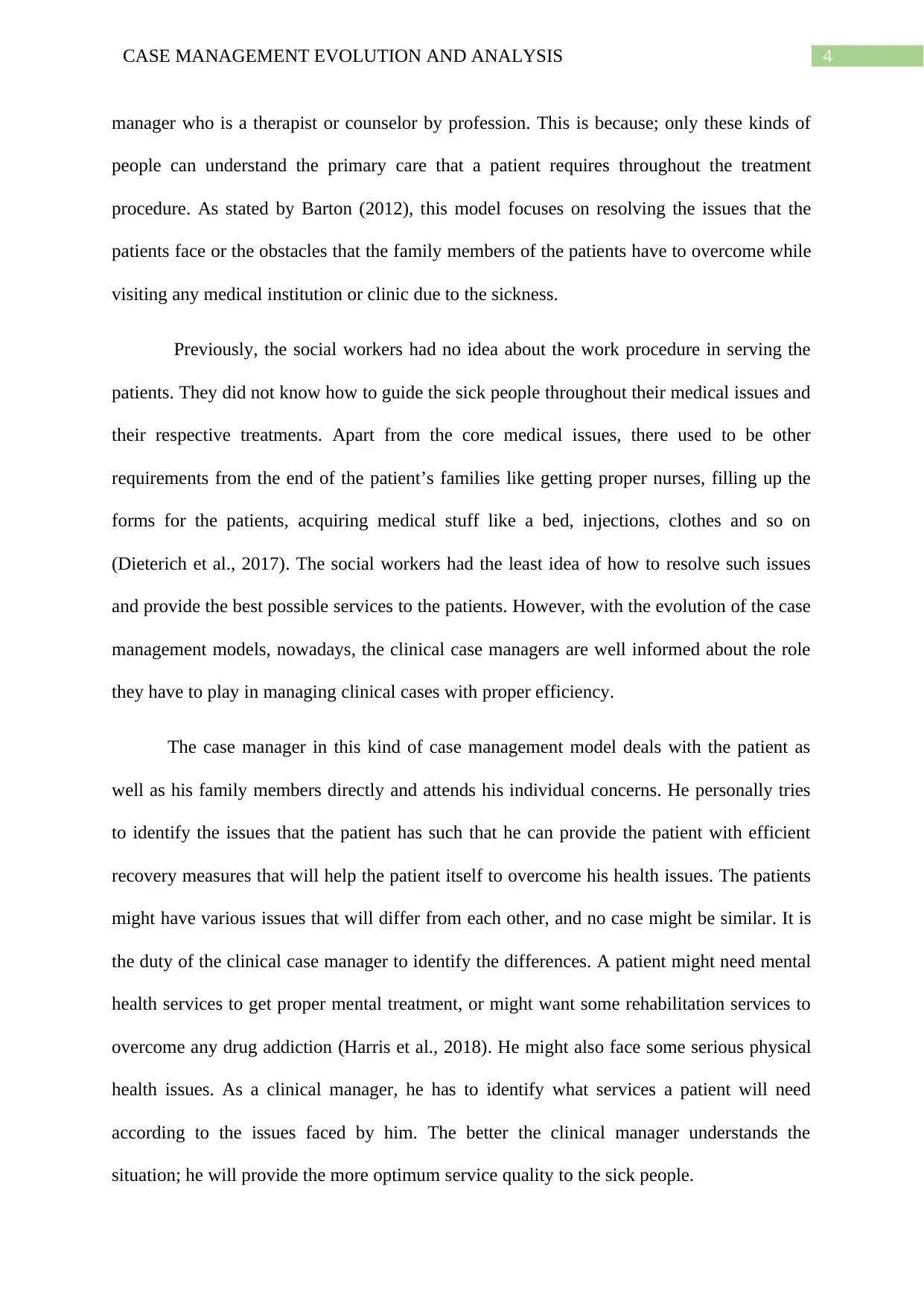
4CASE MANAGEMENT EVOLUTION AND ANALYSIS
manager who is a therapist or counselor by profession. This is because; only these kinds of
people can understand the primary care that a patient requires throughout the treatment
procedure. As stated by Barton (2012), this model focuses on resolving the issues that the
patients face or the obstacles that the family members of the patients have to overcome while
visiting any medical institution or clinic due to the sickness.
Previously, the social workers had no idea about the work procedure in serving the
patients. They did not know how to guide the sick people throughout their medical issues and
their respective treatments. Apart from the core medical issues, there used to be other
requirements from the end of the patient’s families like getting proper nurses, filling up the
forms for the patients, acquiring medical stuff like a bed, injections, clothes and so on
(Dieterich et al., 2017). The social workers had the least idea of how to resolve such issues
and provide the best possible services to the patients. However, with the evolution of the case
management models, nowadays, the clinical case managers are well informed about the role
they have to play in managing clinical cases with proper efficiency.
The case manager in this kind of case management model deals with the patient as
well as his family members directly and attends his individual concerns. He personally tries
to identify the issues that the patient has such that he can provide the patient with efficient
recovery measures that will help the patient itself to overcome his health issues. The patients
might have various issues that will differ from each other, and no case might be similar. It is
the duty of the clinical case manager to identify the differences. A patient might need mental
health services to get proper mental treatment, or might want some rehabilitation services to
overcome any drug addiction (Harris et al., 2018). He might also face some serious physical
health issues. As a clinical manager, he has to identify what services a patient will need
according to the issues faced by him. The better the clinical manager understands the
situation; he will provide the more optimum service quality to the sick people.
manager who is a therapist or counselor by profession. This is because; only these kinds of
people can understand the primary care that a patient requires throughout the treatment
procedure. As stated by Barton (2012), this model focuses on resolving the issues that the
patients face or the obstacles that the family members of the patients have to overcome while
visiting any medical institution or clinic due to the sickness.
Previously, the social workers had no idea about the work procedure in serving the
patients. They did not know how to guide the sick people throughout their medical issues and
their respective treatments. Apart from the core medical issues, there used to be other
requirements from the end of the patient’s families like getting proper nurses, filling up the
forms for the patients, acquiring medical stuff like a bed, injections, clothes and so on
(Dieterich et al., 2017). The social workers had the least idea of how to resolve such issues
and provide the best possible services to the patients. However, with the evolution of the case
management models, nowadays, the clinical case managers are well informed about the role
they have to play in managing clinical cases with proper efficiency.
The case manager in this kind of case management model deals with the patient as
well as his family members directly and attends his individual concerns. He personally tries
to identify the issues that the patient has such that he can provide the patient with efficient
recovery measures that will help the patient itself to overcome his health issues. The patients
might have various issues that will differ from each other, and no case might be similar. It is
the duty of the clinical case manager to identify the differences. A patient might need mental
health services to get proper mental treatment, or might want some rehabilitation services to
overcome any drug addiction (Harris et al., 2018). He might also face some serious physical
health issues. As a clinical manager, he has to identify what services a patient will need
according to the issues faced by him. The better the clinical manager understands the
situation; he will provide the more optimum service quality to the sick people.
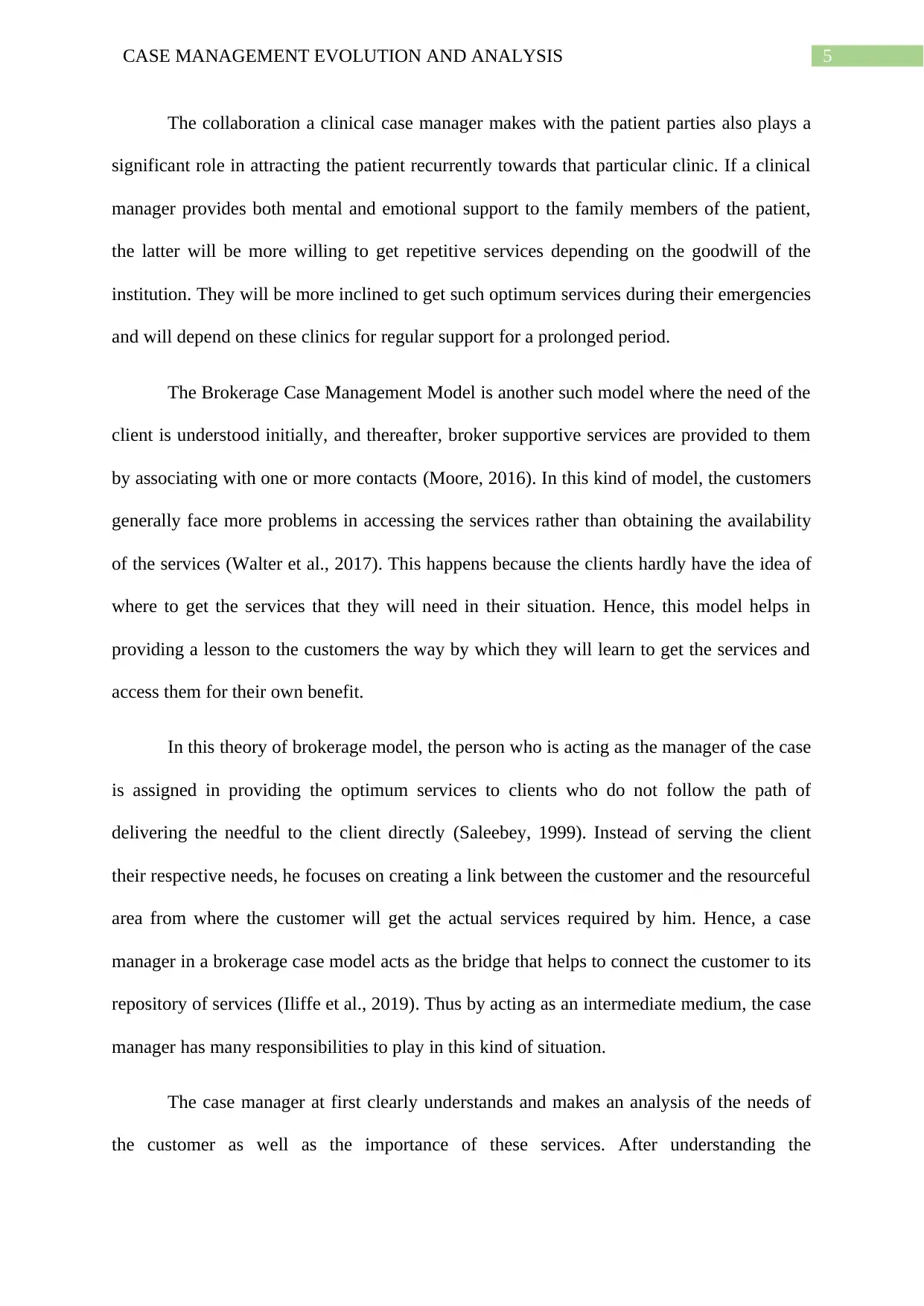
5CASE MANAGEMENT EVOLUTION AND ANALYSIS
The collaboration a clinical case manager makes with the patient parties also plays a
significant role in attracting the patient recurrently towards that particular clinic. If a clinical
manager provides both mental and emotional support to the family members of the patient,
the latter will be more willing to get repetitive services depending on the goodwill of the
institution. They will be more inclined to get such optimum services during their emergencies
and will depend on these clinics for regular support for a prolonged period.
The Brokerage Case Management Model is another such model where the need of the
client is understood initially, and thereafter, broker supportive services are provided to them
by associating with one or more contacts (Moore, 2016). In this kind of model, the customers
generally face more problems in accessing the services rather than obtaining the availability
of the services (Walter et al., 2017). This happens because the clients hardly have the idea of
where to get the services that they will need in their situation. Hence, this model helps in
providing a lesson to the customers the way by which they will learn to get the services and
access them for their own benefit.
In this theory of brokerage model, the person who is acting as the manager of the case
is assigned in providing the optimum services to clients who do not follow the path of
delivering the needful to the client directly (Saleebey, 1999). Instead of serving the client
their respective needs, he focuses on creating a link between the customer and the resourceful
area from where the customer will get the actual services required by him. Hence, a case
manager in a brokerage case model acts as the bridge that helps to connect the customer to its
repository of services (Iliffe et al., 2019). Thus by acting as an intermediate medium, the case
manager has many responsibilities to play in this kind of situation.
The case manager at first clearly understands and makes an analysis of the needs of
the customer as well as the importance of these services. After understanding the
The collaboration a clinical case manager makes with the patient parties also plays a
significant role in attracting the patient recurrently towards that particular clinic. If a clinical
manager provides both mental and emotional support to the family members of the patient,
the latter will be more willing to get repetitive services depending on the goodwill of the
institution. They will be more inclined to get such optimum services during their emergencies
and will depend on these clinics for regular support for a prolonged period.
The Brokerage Case Management Model is another such model where the need of the
client is understood initially, and thereafter, broker supportive services are provided to them
by associating with one or more contacts (Moore, 2016). In this kind of model, the customers
generally face more problems in accessing the services rather than obtaining the availability
of the services (Walter et al., 2017). This happens because the clients hardly have the idea of
where to get the services that they will need in their situation. Hence, this model helps in
providing a lesson to the customers the way by which they will learn to get the services and
access them for their own benefit.
In this theory of brokerage model, the person who is acting as the manager of the case
is assigned in providing the optimum services to clients who do not follow the path of
delivering the needful to the client directly (Saleebey, 1999). Instead of serving the client
their respective needs, he focuses on creating a link between the customer and the resourceful
area from where the customer will get the actual services required by him. Hence, a case
manager in a brokerage case model acts as the bridge that helps to connect the customer to its
repository of services (Iliffe et al., 2019). Thus by acting as an intermediate medium, the case
manager has many responsibilities to play in this kind of situation.
The case manager at first clearly understands and makes an analysis of the needs of
the customer as well as the importance of these services. After understanding the
⊘ This is a preview!⊘
Do you want full access?
Subscribe today to unlock all pages.

Trusted by 1+ million students worldwide
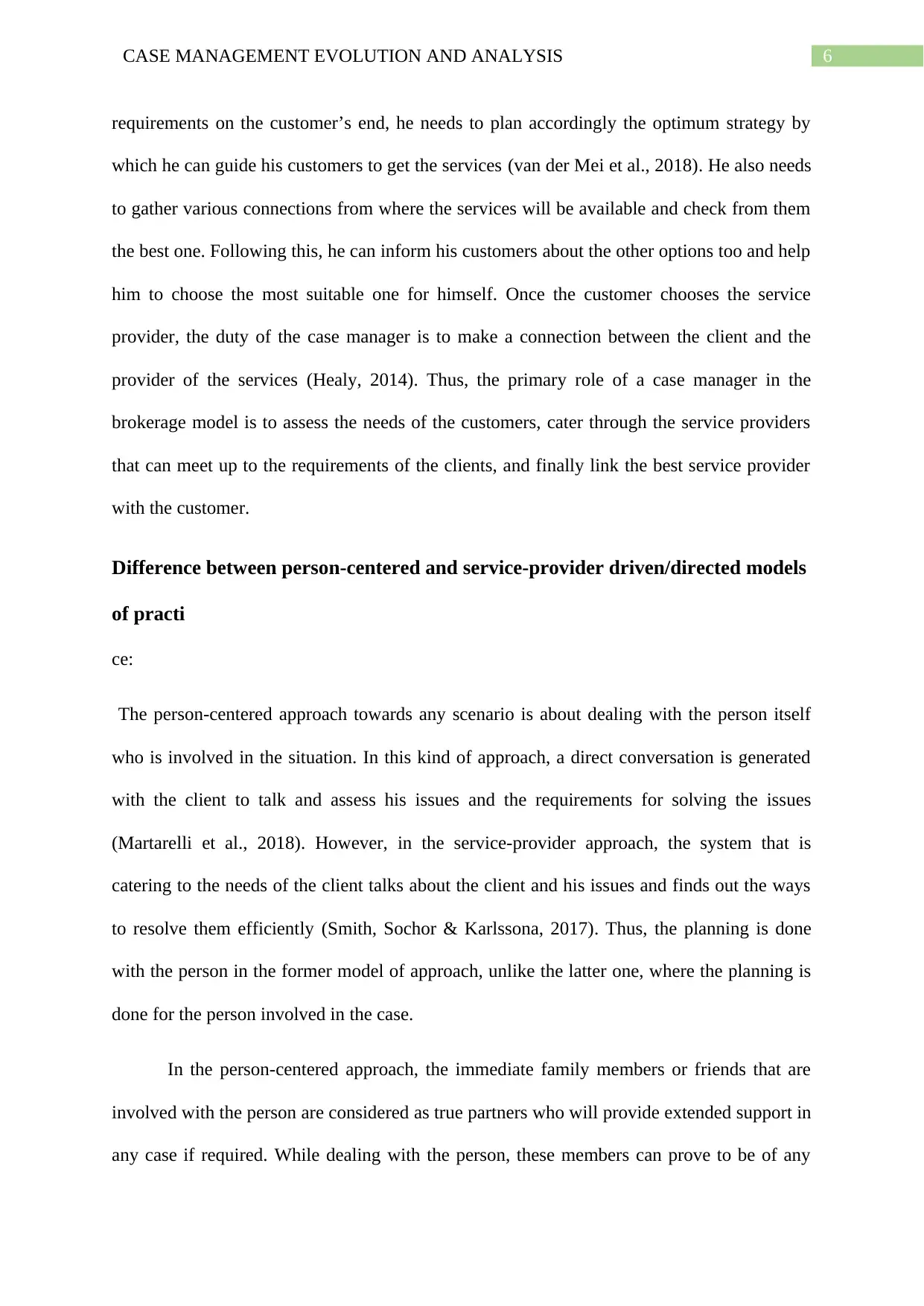
6CASE MANAGEMENT EVOLUTION AND ANALYSIS
requirements on the customer’s end, he needs to plan accordingly the optimum strategy by
which he can guide his customers to get the services (van der Mei et al., 2018). He also needs
to gather various connections from where the services will be available and check from them
the best one. Following this, he can inform his customers about the other options too and help
him to choose the most suitable one for himself. Once the customer chooses the service
provider, the duty of the case manager is to make a connection between the client and the
provider of the services (Healy, 2014). Thus, the primary role of a case manager in the
brokerage model is to assess the needs of the customers, cater through the service providers
that can meet up to the requirements of the clients, and finally link the best service provider
with the customer.
Difference between person-centered and service-provider driven/directed models
of practi
ce:
The person-centered approach towards any scenario is about dealing with the person itself
who is involved in the situation. In this kind of approach, a direct conversation is generated
with the client to talk and assess his issues and the requirements for solving the issues
(Martarelli et al., 2018). However, in the service-provider approach, the system that is
catering to the needs of the client talks about the client and his issues and finds out the ways
to resolve them efficiently (Smith, Sochor & Karlssona, 2017). Thus, the planning is done
with the person in the former model of approach, unlike the latter one, where the planning is
done for the person involved in the case.
In the person-centered approach, the immediate family members or friends that are
involved with the person are considered as true partners who will provide extended support in
any case if required. While dealing with the person, these members can prove to be of any
requirements on the customer’s end, he needs to plan accordingly the optimum strategy by
which he can guide his customers to get the services (van der Mei et al., 2018). He also needs
to gather various connections from where the services will be available and check from them
the best one. Following this, he can inform his customers about the other options too and help
him to choose the most suitable one for himself. Once the customer chooses the service
provider, the duty of the case manager is to make a connection between the client and the
provider of the services (Healy, 2014). Thus, the primary role of a case manager in the
brokerage model is to assess the needs of the customers, cater through the service providers
that can meet up to the requirements of the clients, and finally link the best service provider
with the customer.
Difference between person-centered and service-provider driven/directed models
of practi
ce:
The person-centered approach towards any scenario is about dealing with the person itself
who is involved in the situation. In this kind of approach, a direct conversation is generated
with the client to talk and assess his issues and the requirements for solving the issues
(Martarelli et al., 2018). However, in the service-provider approach, the system that is
catering to the needs of the client talks about the client and his issues and finds out the ways
to resolve them efficiently (Smith, Sochor & Karlssona, 2017). Thus, the planning is done
with the person in the former model of approach, unlike the latter one, where the planning is
done for the person involved in the case.
In the person-centered approach, the immediate family members or friends that are
involved with the person are considered as true partners who will provide extended support in
any case if required. While dealing with the person, these members can prove to be of any
Paraphrase This Document
Need a fresh take? Get an instant paraphrase of this document with our AI Paraphraser
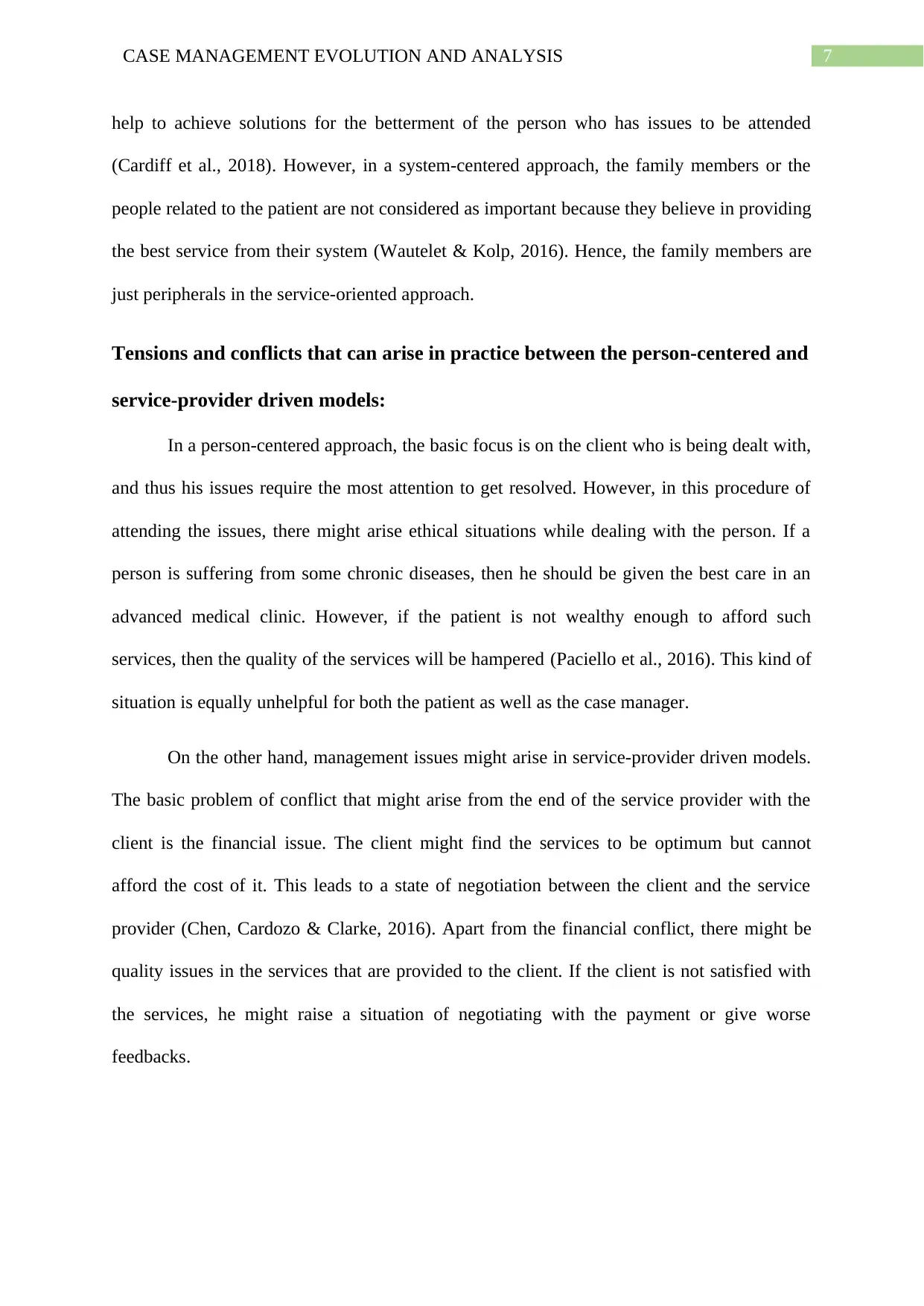
7CASE MANAGEMENT EVOLUTION AND ANALYSIS
help to achieve solutions for the betterment of the person who has issues to be attended
(Cardiff et al., 2018). However, in a system-centered approach, the family members or the
people related to the patient are not considered as important because they believe in providing
the best service from their system (Wautelet & Kolp, 2016). Hence, the family members are
just peripherals in the service-oriented approach.
Tensions and conflicts that can arise in practice between the person-centered and
service-provider driven models:
In a person-centered approach, the basic focus is on the client who is being dealt with,
and thus his issues require the most attention to get resolved. However, in this procedure of
attending the issues, there might arise ethical situations while dealing with the person. If a
person is suffering from some chronic diseases, then he should be given the best care in an
advanced medical clinic. However, if the patient is not wealthy enough to afford such
services, then the quality of the services will be hampered (Paciello et al., 2016). This kind of
situation is equally unhelpful for both the patient as well as the case manager.
On the other hand, management issues might arise in service-provider driven models.
The basic problem of conflict that might arise from the end of the service provider with the
client is the financial issue. The client might find the services to be optimum but cannot
afford the cost of it. This leads to a state of negotiation between the client and the service
provider (Chen, Cardozo & Clarke, 2016). Apart from the financial conflict, there might be
quality issues in the services that are provided to the client. If the client is not satisfied with
the services, he might raise a situation of negotiating with the payment or give worse
feedbacks.
help to achieve solutions for the betterment of the person who has issues to be attended
(Cardiff et al., 2018). However, in a system-centered approach, the family members or the
people related to the patient are not considered as important because they believe in providing
the best service from their system (Wautelet & Kolp, 2016). Hence, the family members are
just peripherals in the service-oriented approach.
Tensions and conflicts that can arise in practice between the person-centered and
service-provider driven models:
In a person-centered approach, the basic focus is on the client who is being dealt with,
and thus his issues require the most attention to get resolved. However, in this procedure of
attending the issues, there might arise ethical situations while dealing with the person. If a
person is suffering from some chronic diseases, then he should be given the best care in an
advanced medical clinic. However, if the patient is not wealthy enough to afford such
services, then the quality of the services will be hampered (Paciello et al., 2016). This kind of
situation is equally unhelpful for both the patient as well as the case manager.
On the other hand, management issues might arise in service-provider driven models.
The basic problem of conflict that might arise from the end of the service provider with the
client is the financial issue. The client might find the services to be optimum but cannot
afford the cost of it. This leads to a state of negotiation between the client and the service
provider (Chen, Cardozo & Clarke, 2016). Apart from the financial conflict, there might be
quality issues in the services that are provided to the client. If the client is not satisfied with
the services, he might raise a situation of negotiating with the payment or give worse
feedbacks.
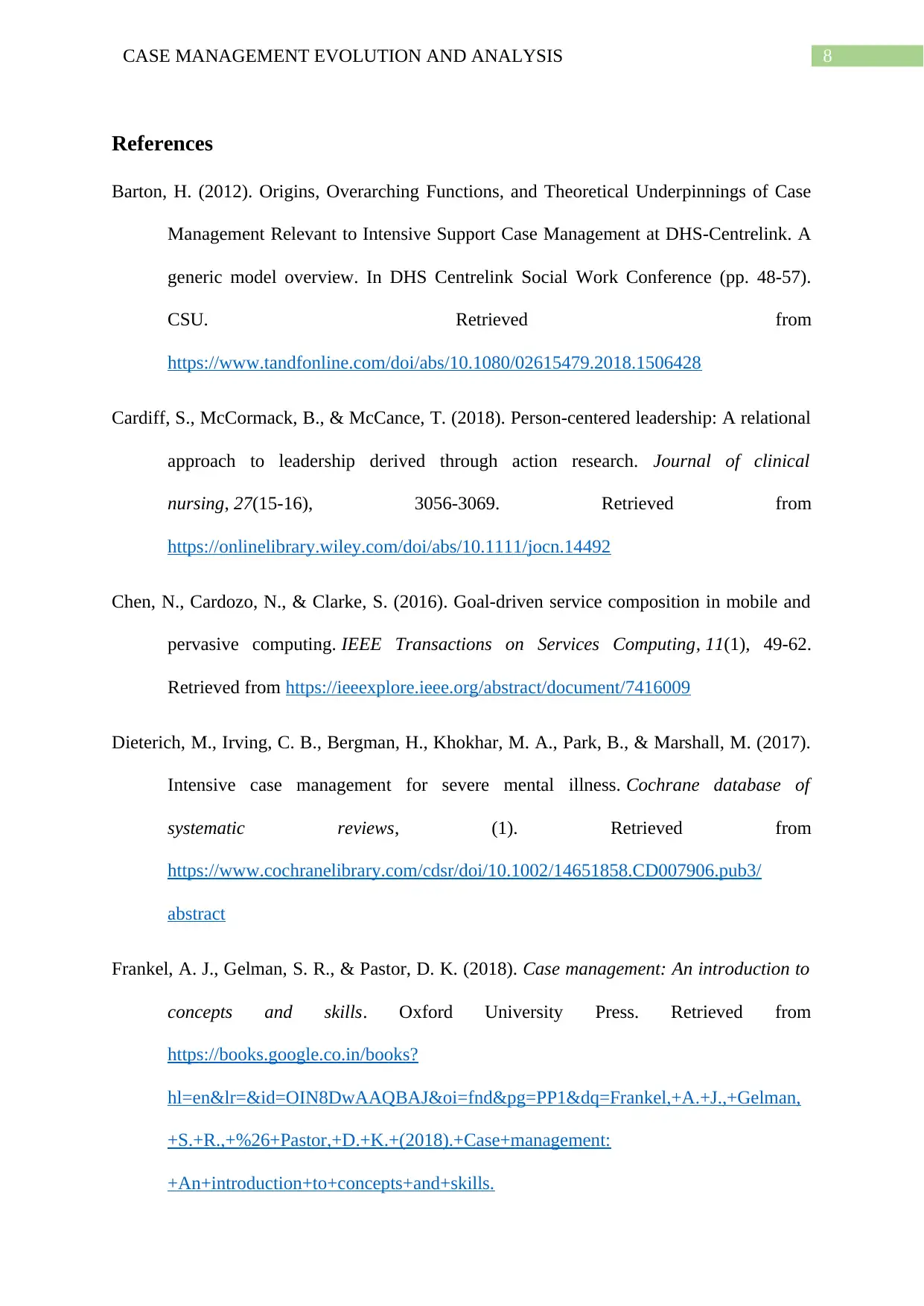
8CASE MANAGEMENT EVOLUTION AND ANALYSIS
References
Barton, H. (2012). Origins, Overarching Functions, and Theoretical Underpinnings of Case
Management Relevant to Intensive Support Case Management at DHS-Centrelink. A
generic model overview. In DHS Centrelink Social Work Conference (pp. 48-57).
CSU. Retrieved from
https://www.tandfonline.com/doi/abs/10.1080/02615479.2018.1506428
Cardiff, S., McCormack, B., & McCance, T. (2018). Person-centered leadership: A relational
approach to leadership derived through action research. Journal of clinical
nursing, 27(15-16), 3056-3069. Retrieved from
https://onlinelibrary.wiley.com/doi/abs/10.1111/jocn.14492
Chen, N., Cardozo, N., & Clarke, S. (2016). Goal-driven service composition in mobile and
pervasive computing. IEEE Transactions on Services Computing, 11(1), 49-62.
Retrieved from https://ieeexplore.ieee.org/abstract/document/7416009
Dieterich, M., Irving, C. B., Bergman, H., Khokhar, M. A., Park, B., & Marshall, M. (2017).
Intensive case management for severe mental illness. Cochrane database of
systematic reviews, (1). Retrieved from
https://www.cochranelibrary.com/cdsr/doi/10.1002/14651858.CD007906.pub3/
abstract
Frankel, A. J., Gelman, S. R., & Pastor, D. K. (2018). Case management: An introduction to
concepts and skills. Oxford University Press. Retrieved from
https://books.google.co.in/books?
hl=en&lr=&id=OIN8DwAAQBAJ&oi=fnd&pg=PP1&dq=Frankel,+A.+J.,+Gelman,
+S.+R.,+%26+Pastor,+D.+K.+(2018).+Case+management:
+An+introduction+to+concepts+and+skills.
References
Barton, H. (2012). Origins, Overarching Functions, and Theoretical Underpinnings of Case
Management Relevant to Intensive Support Case Management at DHS-Centrelink. A
generic model overview. In DHS Centrelink Social Work Conference (pp. 48-57).
CSU. Retrieved from
https://www.tandfonline.com/doi/abs/10.1080/02615479.2018.1506428
Cardiff, S., McCormack, B., & McCance, T. (2018). Person-centered leadership: A relational
approach to leadership derived through action research. Journal of clinical
nursing, 27(15-16), 3056-3069. Retrieved from
https://onlinelibrary.wiley.com/doi/abs/10.1111/jocn.14492
Chen, N., Cardozo, N., & Clarke, S. (2016). Goal-driven service composition in mobile and
pervasive computing. IEEE Transactions on Services Computing, 11(1), 49-62.
Retrieved from https://ieeexplore.ieee.org/abstract/document/7416009
Dieterich, M., Irving, C. B., Bergman, H., Khokhar, M. A., Park, B., & Marshall, M. (2017).
Intensive case management for severe mental illness. Cochrane database of
systematic reviews, (1). Retrieved from
https://www.cochranelibrary.com/cdsr/doi/10.1002/14651858.CD007906.pub3/
abstract
Frankel, A. J., Gelman, S. R., & Pastor, D. K. (2018). Case management: An introduction to
concepts and skills. Oxford University Press. Retrieved from
https://books.google.co.in/books?
hl=en&lr=&id=OIN8DwAAQBAJ&oi=fnd&pg=PP1&dq=Frankel,+A.+J.,+Gelman,
+S.+R.,+%26+Pastor,+D.+K.+(2018).+Case+management:
+An+introduction+to+concepts+and+skills.
⊘ This is a preview!⊘
Do you want full access?
Subscribe today to unlock all pages.

Trusted by 1+ million students worldwide
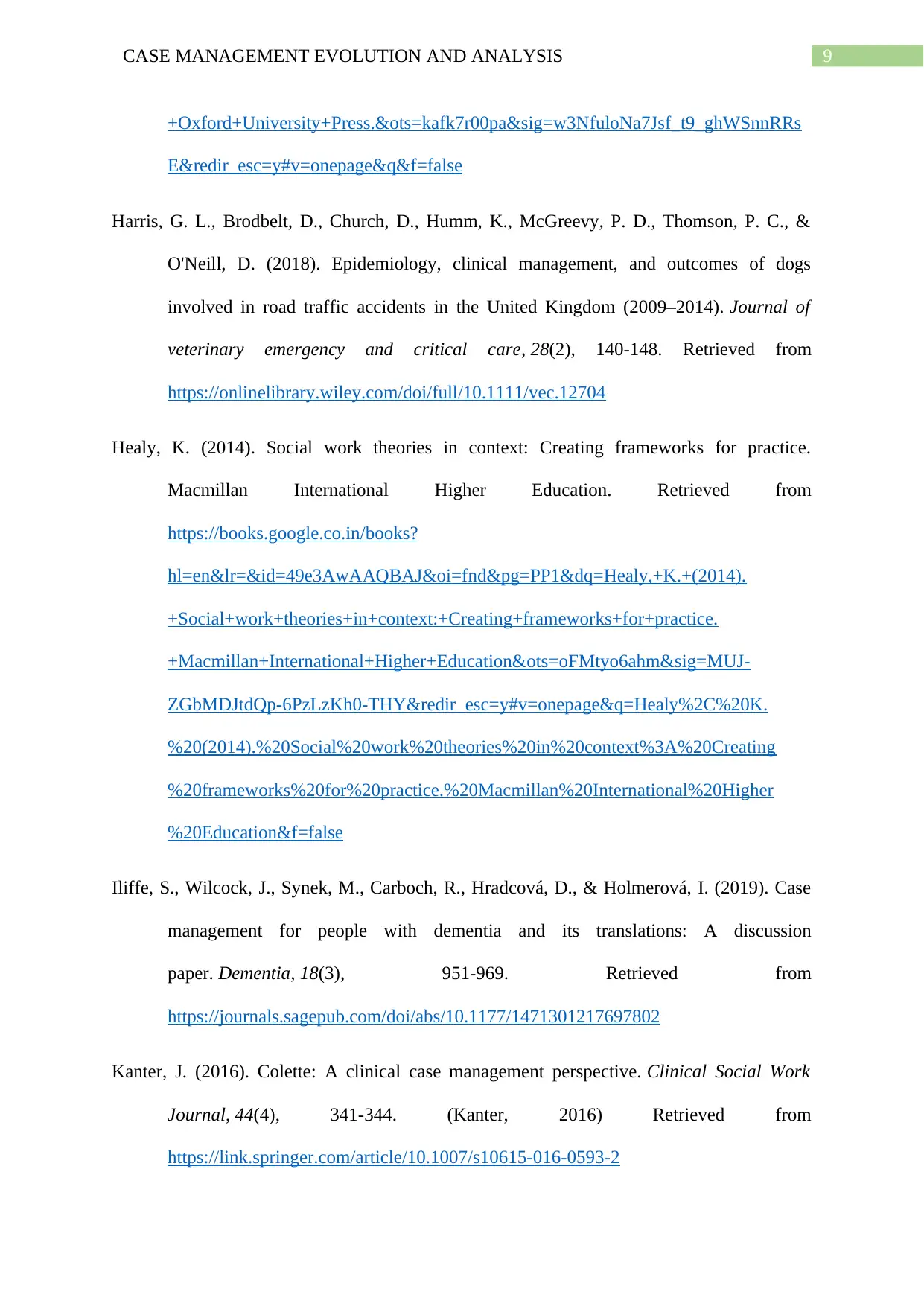
9CASE MANAGEMENT EVOLUTION AND ANALYSIS
+Oxford+University+Press.&ots=kafk7r00pa&sig=w3NfuloNa7Jsf_t9_ghWSnnRRs
E&redir_esc=y#v=onepage&q&f=false
Harris, G. L., Brodbelt, D., Church, D., Humm, K., McGreevy, P. D., Thomson, P. C., &
O'Neill, D. (2018). Epidemiology, clinical management, and outcomes of dogs
involved in road traffic accidents in the United Kingdom (2009–2014). Journal of
veterinary emergency and critical care, 28(2), 140-148. Retrieved from
https://onlinelibrary.wiley.com/doi/full/10.1111/vec.12704
Healy, K. (2014). Social work theories in context: Creating frameworks for practice.
Macmillan International Higher Education. Retrieved from
https://books.google.co.in/books?
hl=en&lr=&id=49e3AwAAQBAJ&oi=fnd&pg=PP1&dq=Healy,+K.+(2014).
+Social+work+theories+in+context:+Creating+frameworks+for+practice.
+Macmillan+International+Higher+Education&ots=oFMtyo6ahm&sig=MUJ-
ZGbMDJtdQp-6PzLzKh0-THY&redir_esc=y#v=onepage&q=Healy%2C%20K.
%20(2014).%20Social%20work%20theories%20in%20context%3A%20Creating
%20frameworks%20for%20practice.%20Macmillan%20International%20Higher
%20Education&f=false
Iliffe, S., Wilcock, J., Synek, M., Carboch, R., Hradcová, D., & Holmerová, I. (2019). Case
management for people with dementia and its translations: A discussion
paper. Dementia, 18(3), 951-969. Retrieved from
https://journals.sagepub.com/doi/abs/10.1177/1471301217697802
Kanter, J. (2016). Colette: A clinical case management perspective. Clinical Social Work
Journal, 44(4), 341-344. (Kanter, 2016) Retrieved from
https://link.springer.com/article/10.1007/s10615-016-0593-2
+Oxford+University+Press.&ots=kafk7r00pa&sig=w3NfuloNa7Jsf_t9_ghWSnnRRs
E&redir_esc=y#v=onepage&q&f=false
Harris, G. L., Brodbelt, D., Church, D., Humm, K., McGreevy, P. D., Thomson, P. C., &
O'Neill, D. (2018). Epidemiology, clinical management, and outcomes of dogs
involved in road traffic accidents in the United Kingdom (2009–2014). Journal of
veterinary emergency and critical care, 28(2), 140-148. Retrieved from
https://onlinelibrary.wiley.com/doi/full/10.1111/vec.12704
Healy, K. (2014). Social work theories in context: Creating frameworks for practice.
Macmillan International Higher Education. Retrieved from
https://books.google.co.in/books?
hl=en&lr=&id=49e3AwAAQBAJ&oi=fnd&pg=PP1&dq=Healy,+K.+(2014).
+Social+work+theories+in+context:+Creating+frameworks+for+practice.
+Macmillan+International+Higher+Education&ots=oFMtyo6ahm&sig=MUJ-
ZGbMDJtdQp-6PzLzKh0-THY&redir_esc=y#v=onepage&q=Healy%2C%20K.
%20(2014).%20Social%20work%20theories%20in%20context%3A%20Creating
%20frameworks%20for%20practice.%20Macmillan%20International%20Higher
%20Education&f=false
Iliffe, S., Wilcock, J., Synek, M., Carboch, R., Hradcová, D., & Holmerová, I. (2019). Case
management for people with dementia and its translations: A discussion
paper. Dementia, 18(3), 951-969. Retrieved from
https://journals.sagepub.com/doi/abs/10.1177/1471301217697802
Kanter, J. (2016). Colette: A clinical case management perspective. Clinical Social Work
Journal, 44(4), 341-344. (Kanter, 2016) Retrieved from
https://link.springer.com/article/10.1007/s10615-016-0593-2
Paraphrase This Document
Need a fresh take? Get an instant paraphrase of this document with our AI Paraphraser
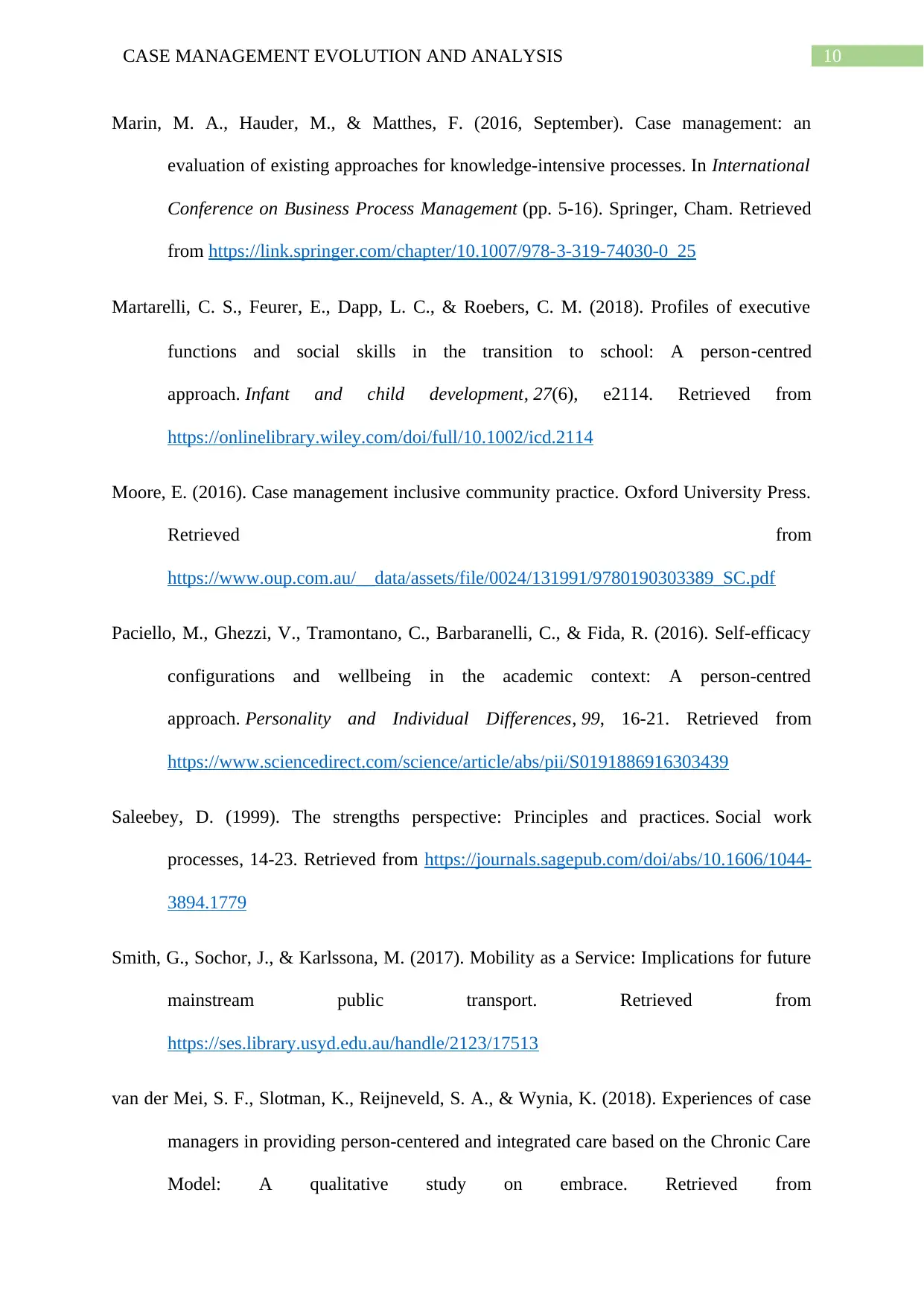
10CASE MANAGEMENT EVOLUTION AND ANALYSIS
Marin, M. A., Hauder, M., & Matthes, F. (2016, September). Case management: an
evaluation of existing approaches for knowledge-intensive processes. In International
Conference on Business Process Management (pp. 5-16). Springer, Cham. Retrieved
from https://link.springer.com/chapter/10.1007/978-3-319-74030-0_25
Martarelli, C. S., Feurer, E., Dapp, L. C., & Roebers, C. M. (2018). Profiles of executive
functions and social skills in the transition to school: A person‐centred
approach. Infant and child development, 27(6), e2114. Retrieved from
https://onlinelibrary.wiley.com/doi/full/10.1002/icd.2114
Moore, E. (2016). Case management inclusive community practice. Oxford University Press.
Retrieved from
https://www.oup.com.au/__data/assets/file/0024/131991/9780190303389_SC.pdf
Paciello, M., Ghezzi, V., Tramontano, C., Barbaranelli, C., & Fida, R. (2016). Self-efficacy
configurations and wellbeing in the academic context: A person-centred
approach. Personality and Individual Differences, 99, 16-21. Retrieved from
https://www.sciencedirect.com/science/article/abs/pii/S0191886916303439
Saleebey, D. (1999). The strengths perspective: Principles and practices. Social work
processes, 14-23. Retrieved from https://journals.sagepub.com/doi/abs/10.1606/1044-
3894.1779
Smith, G., Sochor, J., & Karlssona, M. (2017). Mobility as a Service: Implications for future
mainstream public transport. Retrieved from
https://ses.library.usyd.edu.au/handle/2123/17513
van der Mei, S. F., Slotman, K., Reijneveld, S. A., & Wynia, K. (2018). Experiences of case
managers in providing person-centered and integrated care based on the Chronic Care
Model: A qualitative study on embrace. Retrieved from
Marin, M. A., Hauder, M., & Matthes, F. (2016, September). Case management: an
evaluation of existing approaches for knowledge-intensive processes. In International
Conference on Business Process Management (pp. 5-16). Springer, Cham. Retrieved
from https://link.springer.com/chapter/10.1007/978-3-319-74030-0_25
Martarelli, C. S., Feurer, E., Dapp, L. C., & Roebers, C. M. (2018). Profiles of executive
functions and social skills in the transition to school: A person‐centred
approach. Infant and child development, 27(6), e2114. Retrieved from
https://onlinelibrary.wiley.com/doi/full/10.1002/icd.2114
Moore, E. (2016). Case management inclusive community practice. Oxford University Press.
Retrieved from
https://www.oup.com.au/__data/assets/file/0024/131991/9780190303389_SC.pdf
Paciello, M., Ghezzi, V., Tramontano, C., Barbaranelli, C., & Fida, R. (2016). Self-efficacy
configurations and wellbeing in the academic context: A person-centred
approach. Personality and Individual Differences, 99, 16-21. Retrieved from
https://www.sciencedirect.com/science/article/abs/pii/S0191886916303439
Saleebey, D. (1999). The strengths perspective: Principles and practices. Social work
processes, 14-23. Retrieved from https://journals.sagepub.com/doi/abs/10.1606/1044-
3894.1779
Smith, G., Sochor, J., & Karlssona, M. (2017). Mobility as a Service: Implications for future
mainstream public transport. Retrieved from
https://ses.library.usyd.edu.au/handle/2123/17513
van der Mei, S. F., Slotman, K., Reijneveld, S. A., & Wynia, K. (2018). Experiences of case
managers in providing person-centered and integrated care based on the Chronic Care
Model: A qualitative study on embrace. Retrieved from
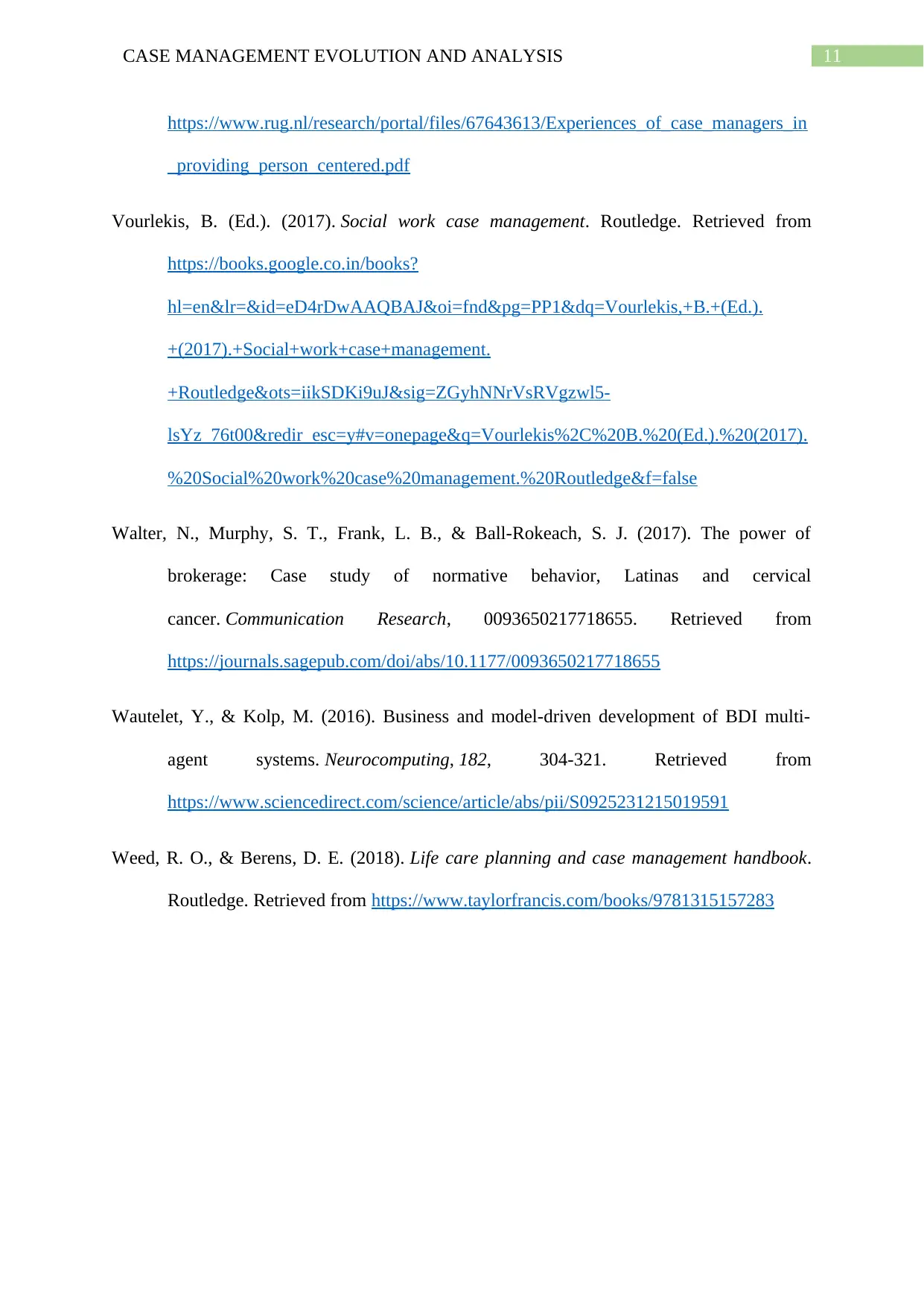
11CASE MANAGEMENT EVOLUTION AND ANALYSIS
https://www.rug.nl/research/portal/files/67643613/Experiences_of_case_managers_in
_providing_person_centered.pdf
Vourlekis, B. (Ed.). (2017). Social work case management. Routledge. Retrieved from
https://books.google.co.in/books?
hl=en&lr=&id=eD4rDwAAQBAJ&oi=fnd&pg=PP1&dq=Vourlekis,+B.+(Ed.).
+(2017).+Social+work+case+management.
+Routledge&ots=iikSDKi9uJ&sig=ZGyhNNrVsRVgzwl5-
lsYz_76t00&redir_esc=y#v=onepage&q=Vourlekis%2C%20B.%20(Ed.).%20(2017).
%20Social%20work%20case%20management.%20Routledge&f=false
Walter, N., Murphy, S. T., Frank, L. B., & Ball-Rokeach, S. J. (2017). The power of
brokerage: Case study of normative behavior, Latinas and cervical
cancer. Communication Research, 0093650217718655. Retrieved from
https://journals.sagepub.com/doi/abs/10.1177/0093650217718655
Wautelet, Y., & Kolp, M. (2016). Business and model-driven development of BDI multi-
agent systems. Neurocomputing, 182, 304-321. Retrieved from
https://www.sciencedirect.com/science/article/abs/pii/S0925231215019591
Weed, R. O., & Berens, D. E. (2018). Life care planning and case management handbook.
Routledge. Retrieved from https://www.taylorfrancis.com/books/9781315157283
https://www.rug.nl/research/portal/files/67643613/Experiences_of_case_managers_in
_providing_person_centered.pdf
Vourlekis, B. (Ed.). (2017). Social work case management. Routledge. Retrieved from
https://books.google.co.in/books?
hl=en&lr=&id=eD4rDwAAQBAJ&oi=fnd&pg=PP1&dq=Vourlekis,+B.+(Ed.).
+(2017).+Social+work+case+management.
+Routledge&ots=iikSDKi9uJ&sig=ZGyhNNrVsRVgzwl5-
lsYz_76t00&redir_esc=y#v=onepage&q=Vourlekis%2C%20B.%20(Ed.).%20(2017).
%20Social%20work%20case%20management.%20Routledge&f=false
Walter, N., Murphy, S. T., Frank, L. B., & Ball-Rokeach, S. J. (2017). The power of
brokerage: Case study of normative behavior, Latinas and cervical
cancer. Communication Research, 0093650217718655. Retrieved from
https://journals.sagepub.com/doi/abs/10.1177/0093650217718655
Wautelet, Y., & Kolp, M. (2016). Business and model-driven development of BDI multi-
agent systems. Neurocomputing, 182, 304-321. Retrieved from
https://www.sciencedirect.com/science/article/abs/pii/S0925231215019591
Weed, R. O., & Berens, D. E. (2018). Life care planning and case management handbook.
Routledge. Retrieved from https://www.taylorfrancis.com/books/9781315157283
⊘ This is a preview!⊘
Do you want full access?
Subscribe today to unlock all pages.

Trusted by 1+ million students worldwide
1 out of 12
Related Documents
Your All-in-One AI-Powered Toolkit for Academic Success.
+13062052269
info@desklib.com
Available 24*7 on WhatsApp / Email
![[object Object]](/_next/static/media/star-bottom.7253800d.svg)
Unlock your academic potential
Copyright © 2020–2025 A2Z Services. All Rights Reserved. Developed and managed by ZUCOL.




